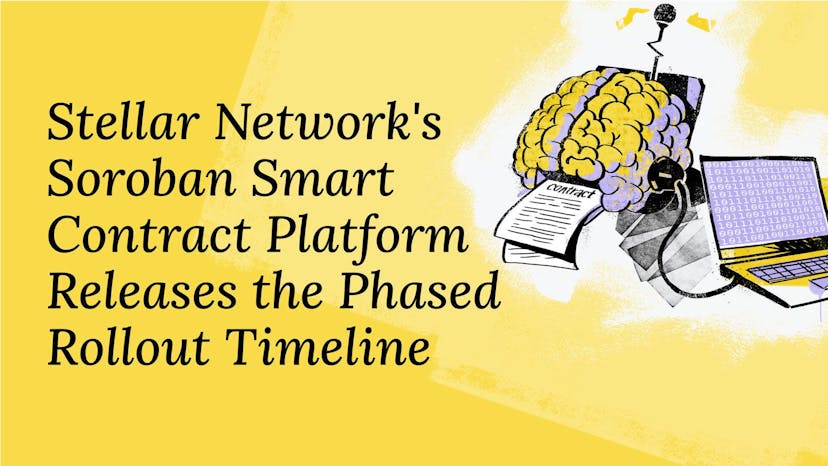Stellar Network's Soroban Smart Contract Platform Releases the Phased Rollout Timeline
SponsoredOver the past two years, the Stellar Development Foundation (SDF) and the wider Stellar community have worked tirelessly to bring smart contract functionality to the Stellar network, which will usher in new capabilities and opportunities that will work wit...
By: Stellar • Loading...
Blockchains
Over the past two years, the Stellar Development Foundation (SDF) and the wider Stellar community have worked tirelessly to bring smart contract functionality to the Stellar network, which will usher in new capabilities and opportunities that will work with all existing network functionality.
Recently the Stellar Development Foundation and the maintainers of key Stellar SDKs announced the release of a full suite of software that supports Protocol 20, which will bring Soroban smart contracts to Stellar. With the technical pieces now in place, Stellar network validators have agreed to a January 30 vote on the Mainnet upgrade to Protocol 20.
Protocol 20 will mark the most transformative upgrade to the Stellar network to date. And to preserve the network's performance, security, and stability during this time, the ecosystem has agreed that a slow and steady process makes a lot of sense. So, following the January 30 vote, validators will deploy a phased approach to gradually and responsibly increase capacity for Soroban transactions to monitor the impact of smart contract functionality on the network.
The Protocol 20 Vote
On January 30th, the network's validators will cast their votes. Should they approve the upgrade, the Stellar network will transition from Protocol 19 to Protocol 20.
After extensive technical development, involving hundreds of thousands of lines of code and over 150 projects tested on Testnet, this upgrade will inaugurate a new phase of Stellar smart contracts technology, characterized by enhanced productivity and scalability.
However, instead of an immediate, all-encompassing rollout, validators will gradually increase the capacity for Soroban transactions on the Mainnet. This means that Soroban dapps will not be fully operational until later stages. This careful strategy allows for a close watch on the impact of smart contract functionality on network performance, security, and stability. As the process unfolds, we will gradually raise the limits for Soroban transactions, aiming to reach a capacity that serves both developers and users effectively. It's important to note that these phases and limits apply only to smart contract functionality. Existing Stellar operations and applications will continue as usual.
Transitioning to Mainnet: A Phased Approach

Phase 0: ENSURING NETWORK STABILITY
Immediately following a positive validator vote, Phase 0 begins, which is designed to allow network operators to observe the network after the upgrade, and not intended for end users to interact with applications. Here, the focus lies in validating key aspects:
- Smoke-testing systems
- Basic contract execution testing
- Uploading network configuration upgrades via contract calls
Throughout Phase 0, developers are encouraged to continue utilizing Testnet for their work, which has enough capacity for testing and development purposes.
Phase 1: DEPLOY & MONITOR
In Phase 1, builders gain the ability to deploy contracts on Mainnet for testing. Like Phase 0, this environment is not meant for application users. This phase focuses on:
- Monitoring contract impact on network performance
- Gradually increasing Soroban transaction capacity
- Validating critical system aspects
As Phase 1 progresses, smart contract usability will expand based on network health and user feedback. This period post-upgrade is crucial for stress-testing the system under increased loads.
Phase 2: USER-READY MAINNET
Phase 2 marks the deployment of a user-ready Mainnet where anyone can deploy and interact with smart contracts on the Stellar network. What does that mean in practice? The network will match the average DeFi transactions for many other blockchains (at or around 10 transactions per second, for those of you who are counting) and users will be free to take advantage of any and all new smart contract functionality integrated into Stellar apps along with all the payment and DEX functionality applications currently offer.
But even this is not the end of the journey. At the core of smart contracts on the Stellar network is scale and sustainability, and efforts to continue to expand capacity and introduce further capabilities to enhance the network's functionalities will be ongoing.
A New Beginning for the Stellar Network
The phased rollout of smart contracts, which validators will vote to ratify at every step, signifies a pivotal moment in the network's evolution. By adopting a measured, step-by-step approach, the Stellar ecosystem is prioritizing stability, performance, and user experience, ensuring an optimized journey for builders and users.
Advertisement
The Defiant Daily
“an industry must-read”
Get an edge in Crypto with our free daily newsletter
Know what matters in Crypto and Web3 with The Defiant Daily newsletter, Mon to Fri
90k+ Defiers informed every day. Unsubscribe anytime.





